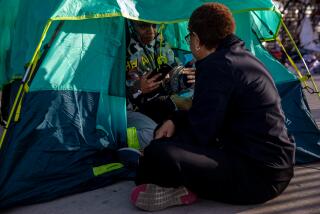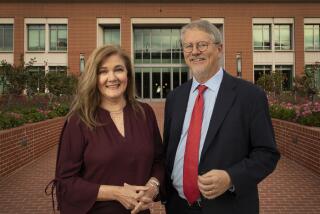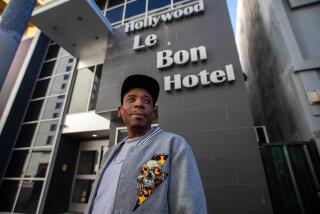Editorial: What’s the endgame for Eric Garcetti’s homeless shelters?
Last week, 45 of the 31,000 homeless people in Los Angeles moved into the first “bridge shelter” to open as part of the temporary housing plan Mayor Eric Garcetti announced in the spring. Situated in a city-owned parking lot in the El Pueblo historic district downtown, the shelter is fashioned out of converted trailers clustered together on an expanse of wooden deck. Inside each trailer stands a row of modest beds separated by 5-foot-high partitions offering a modicum of privacy, along with storage lockers and accommodations that allow occupants to keep a pet. The mayor’s plan is to create 100 new beds in every one of the 15 city council districts — in shelters he says will be less off-putting to homeless people than the usual cot-filled armories.
The impetus for Garcetti’s sudden and concerted push for interim shelter housing was to clear the homeless encampments that city residents increasingly complain have become an annoying blight and a safety concern in their neighborhoods. After all, they voted in 2016 to tax themselves $1.2 billion through Proposition HHH to build 10,000 units of housing, primarily for the chronically homeless. But that housing will take time to build. Meanwhile, street homelessness persists.
The shelters will be located near large existing encampments in the hope of drawing homeless people from them. The El Pueblo site, for example, is near the shops and eateries of Olvera Street where dozens of homeless people congregate day and night. And, unlike traditional shelters that offer nothing more than a bed for the night and a meal, the bridge shelters promise a bed and supportive services for as long as it takes for a homeless person to reach the ultimate goal: placement in a permanent home. The city hopes each shelter resident will attain that placement in less than six months.
The city can’t afford to let the bridge shelter program divert its attention from what should remain its primary goal: building permanent supportive housing.
With nearly 23,000 of Los Angeles’ homeless people living on the streets, in parks or in vehicles, there is clearly a need for more temporary housing while the Proposition HHH-funded units are constructed. And it has to be appealing to homeless people; otherwise, they won’t agree to move in.
But the bridge shelters are costing far more than the city’s initial rough estimate of about $13,000 per bed. The El Pueblo shelter cost four times that much, coming in at $2.4 million. The next one — expected to open in Hollywood in January — will probably cost $3 million to construct. City officials now hope to set aside $75 million — or $50,000 per bed — for the shelters, which city officials have pledged will be removed after three years.
And the shelters aren’t going up as quickly as might be hoped. Two are currently under construction in Hollywood — with a total of 134 beds. Ten more with about 880 beds are close to being approved for development. By mid-2019, more than a year into Garcetti’s shelter project, the city expects all those sites to be open or under construction — but that’s still short of its 1,500-bed target.
More important, what’s the endgame? The city hopes to place the new shelter dwellers into permanent housing after an average stay of three to six months, but that seems highly optimistic. These shelter dwellers will compete with the rest of the 30,000 homeless people in the city for permanent housing. There’s not nearly enough for all of them.
Enter the Fray: First takes on the news of the minute from L.A. Times Opinion »
What’s more, the rate at which homeless people successfully move from bridge housing into permanent housing is notoriously low.
The city can’t afford to let the bridge shelter program divert its attention from what should remain its primary goal: building permanent supportive housing. L.A. needs to focus on getting that housing up faster and cheaper. That means considering such lower-cost options as using prefabricated housing or converted shipping containers. A more controversial alternative that should be on the table is housing more than one homeless person in each unit. Most service providers argue that homeless people need at least a studio apartment to thrive. But some say homeless people can and do succeed in shared apartments where each person has his or her own bedroom.
Temporary housing is fine. But permanent housing for homeless Angelenos must be the priority.
Follow the Opinion section on Twitter @latimesopinion or Facebook
More to Read
A cure for the common opinion
Get thought-provoking perspectives with our weekly newsletter.
You may occasionally receive promotional content from the Los Angeles Times.






